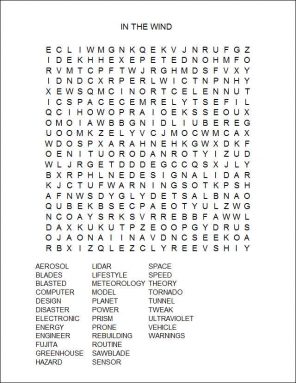Cool Jobs: The power of wind
Scientists study all aspects of wind, from terrible tornadoes to clean energy
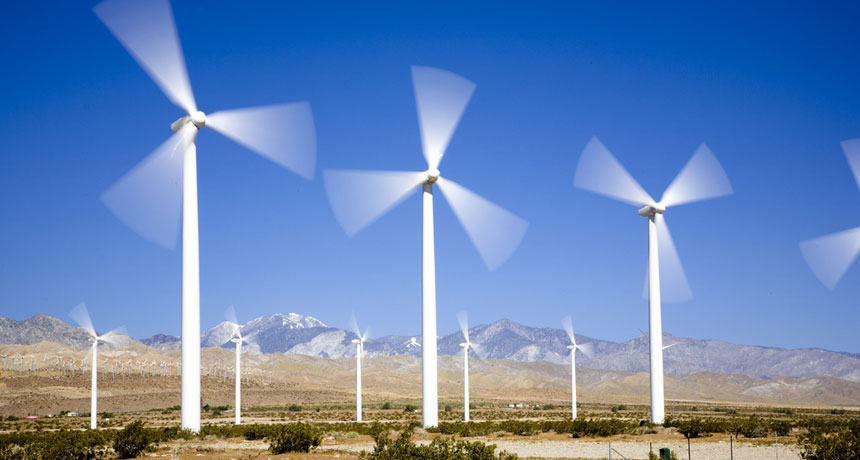
The wind hits turbines on large wind farms at slightly different speeds because each turbine extracts some energy from the air and affects others downwind.
Iberdrola renewables/Flickr
Classroom tornado drills were routine for Harold Brooks as he grew up near St. Louis, Mo. And like many people, he thought tornadoes were fascinating. What else is powerful enough to flip over a train or hurl a saw blade into a tree? “I just didn’t know why they were cool back then,” he says.
Now Brooks works on tornado research. He’s a meteorologist at the National Severe Storms Laboratory in Norman, Okla. The National Oceanic and Atmospheric Administration (NOAA) and the University of Oklahoma in Norman run that facility.
Read on to meet a scientist and two engineers who work with wind. Brooks and his team study tornadoes to help people plan for those destructive twisters. Nettie Roozeboom and her group look at how wind affects planes, buildings and other structures. And Kathryn Johnson and others study wind power to help make renewable energy more practical and cost-effective.
Some of their research just might blow you away.
Tracking tornadoes
Tornadoes can cause awful destruction. Yet they start with plain old wind. “The basic processes that lead to the air moving around in a room can manage to put together something like a tornado,” says Brooks. How? It starts, he says, with little differences in the density of air. To set the stage for a twister, those differences must be really big and “concentrated in a really small area.”
Nationwide, the United States has more than 1,000 tornadoes each year. Experts rate them on the EF (for Enhanced Fujita) scale. That scale goes from 0 to 5. Roughly 500 tornadoes each year are rated EF1 or higher, Brooks notes. EF1 tornadoes can cause minor damage to buildings and shatter windows. In contrast, EF4 tornadoes can flatten houses. The strongest EF5 tornadoes blow them away entirely.
Very strong tornadoes are much rarer than weaker ones. However, climate change is altering the country’s weather patterns. And the number and distribution of really strong tornadoes has shifted, Brooks and other NOAA scientists say.
Forty years ago, the United States had about 150 days each year with at least one tornado that would rank EF1 or higher, Brooks explains. About every other year, there’d be one “big day” with more than 30. Now only about 100 days each year have at least one EF1 tornado. But the average number of days with at least 30 tornadoes has increased to three per year.
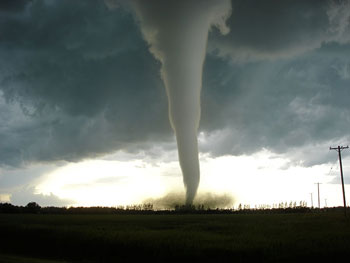
“We haven’t changed the total number of tornadoes,” Brooks says. But now, “they happen on fewer days. And we have more really big days.” The team reported its findings in
Science
in October 2014.
Tornado-prone areas will need more rescue workers, medical teams, electric crews and other workers if multiple disasters strike at the same time. Rebuilding will also cost more if supplies are scarce. But having all those people and other resources ready costs money. And no one knows just which areas will be hit hard.
Brooks also works on how to forecast tornadoes better. May and June generally have more tornadoes than other months. But not always. Tornadoes killed 20 people in the United States in December 2015. And some years are worse than others. Brooks’ team hopes to figure out how to predict whether a season or month will be better or worse than the average for that time of year. If so, Brooks asks, “Could we do it well enough that it actually matters?” In other words, can they make predictions that will really help people?
Brooks’ team also wants to improve tornado warnings. Currently, those warnings deal with imminent threats: Take action to protect your life now, or else. Soon, meteorologists may be able to make more precise predictions. Then maybe people can plan ahead with more certainty. “We’re close to having the technological capability of being able to say there will be a tornado within a few miles of you in an hour,” Brooks says.
Brooks loves working on questions like these. Figuring out the answers is even better. “The thing about being a scientist is there’s that brief moment where you know something that nobody else on the planet has ever known before,” he says. “And then your job is to tell it to other people.”
Tunnel vision
Wind can cause problems even when there isn’t a tornado or hurricane. Wind can make flying choppy and sometimes even deadly. It can also shake buildings and bridges. But smart design and engineering can deal with many of those problems. That’s why Nettie Roozeboom does wind tunnel research. She’s an aerospace engineer with NASA’s Ames Research Center at Moffett Field, Calif.
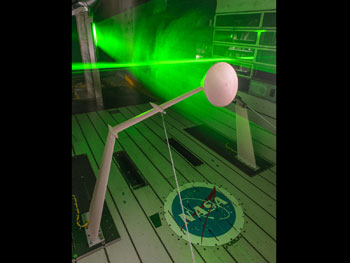
A wind tunnel lets researchers see how fast-moving air affects scale models of different things. “It’s not just for airplanes and space vehicles,” Roozeboom says. Model cars, models of cities, and even tennis, soccer and other balls go inside wind tunnels. There they get blasted with air.
Researchers use different techniques to “measure and then physically see what’s going on,” Roozeboom says. Sometimes they’ll watch how smoke moves around a model in the tunnel. Another way to show how air moves around an object is to measure the pressure on it. Differences in air pressure above and beneath a wing produce lift, and that lets a plane fly. Sometimes researchers attach electronic sensors to parts of a model to measure those pressure differences.
Lately, the tool Roozeboom uses the most — which she calls “wild and crazy” — is pressure-sensitive paint. Here’s how it works: Molecules in the paint fluoresce under ultraviolet (UV) light. They absorb some of the light’s energy and re-emit it as visible light. As a result, the paint seems to glow. How brightly depends on the pressure from the wind. The more pressure, the less the paint glows under UV light. Images of the wind tunnel test show where those pressure points are.
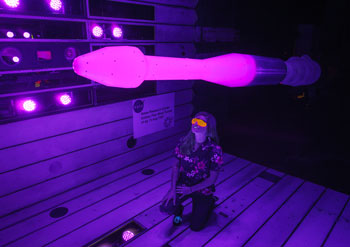
In one study, Roozeboom and her colleagues used the technique to study a type of unsteady wind pressure, called buffeting. A small rectangular block affected wind flowing over a painted surface. The paint showed how the unsteady pressure affected different parts of the surface. Roozeboom reported that work at the January 2016 meeting of the American Institute of Aeronautics and Astronautics. Her team also uses the method to study how wind affects airplanes, space vehicles and other objects.
“You can understand something better when you see it,” she says. “I really love taking the images and having a product that shows what the pressure looks like on the wind tunnel model.” Another benefit is that paint can cover an entire model. Traditional sensors might miss some spots.
Another recent study measured how air moves around an airplane wing. If air doesn’t move smoothly, it causes drag. Drag slows the plane down and makes it use more fuel. Roozeboom’s group reported that work at the January 2015 meeting of the American Institute of Aeronautics and Astronautics.
Wind tunnel research also goes hand-in-hand with computer models. Computer models can use math to predict how the air would flow in a wind tunnel. Wind tunnel research can show how well those math calculations predict what will happen in real life. “That’s really the beauty of it,” Roozeboom says. The results can help improve computer models for the future.
For example, one recent project used computer models to probe how air flows where a wing meets the main body of an airplane. Roozeboom reported that work at the January 2016 meeting of the American Institute of Aeronautics and Astronautics.
Getting more out of wind
Kathryn Johnson puts wind to work to make renewable energy. She’s an electrical engineer and teaches at the Colorado School of Mines in Golden.
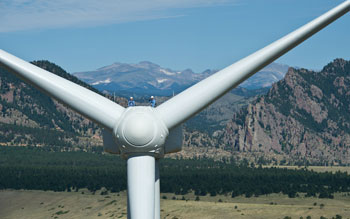
The basic idea behind a wind turbine may seem simple. Moving air spins the blades of a turbine. That turbine then converts the
mechanical
energy into electricity. But running lots of turbines on a wind farm is not so simple. That’s where Johnson comes in.
Ideally, controls for wind farm turbines should work automatically. “Pretend you have an action computer game and you set up an automatic system” to make moves for you in the game, she says. “You develop the theory to basically allow your character in your game to make the right decisions at all times. I’m developing the theory so that the turbine makes the right decisions at all times.”
Often, that can be tricky. For one thing, the wind won’t hit all turbine blades at the same speed. Each turbine extracts some energy from the wind, explains Johnson. So the wind will blow a bit more slowly at each successive turbine. Shifting winds also can change how each turbine affects its neighbor.
Those slight differences can lower the energy output from some of the turbines. A less efficient wind farm is less profitable. So wind farm operators want to make all turbines as efficient as possible.
To help them, Johnson and her colleagues developed a computer model. It shows how two wind turbines would operate together. Engineers can use the tool to see how different tweaks might make downwind turbines produce more energy. The angle of the blades to the oncoming wind might be adjusted, for example.
The team published its work in the December 2015 issue of Wind Energy.
BLOWN AWAY This video explains how modern wind turbines generate electricity — and why they have to be so tall. U.S. Department of Energy |
High wind speeds can also become a big problem. Wind turbines are designed to work at a maximum safe speed. “If you go too fast, you risk shaking things apart,” says Johnson.
Unless winds are at gale force, tweaks like adjusting the blade angles can help there, too. But wind farms still need ways to do that automatically. A control system that could make those changes before a strong wind hits would be even better.
In the February 2015 issue of Wind Energy, Johnson and her team showed how to do just that using a technology known as lidar. That’s short for Light Detection And Ranging.
“Lidar is basically radar with light,” Johnson explains. The team used a computer model to show how things would work. A device near a wind turbine shoots out a laser beam. “It bounces off aerosols in the air — very little particles — and comes back to the lidar.” Equipment could use the returning signal to calculate oncoming wind speeds. The control system would then have time to adjust.
Computer models help show what would happen without putting millions of dollars of equipment at risk. Now Johnson and her colleagues are looking to test some ideas at actual wind farms.
“The ultimate goal is to get more energy for less money,” she says. That in turn can make it easier for society to shift to cleaner sources of energy. Doing that will reduce the amount of greenhouse gases and other pollutants that power plants currently spew into the air.
Brooks, Roozeboom and Johnson aim to protect people from disaster, to streamline travel and building, and to improve clean energy. By harnessing the power of wind, they’re working to help all of us live better — no matter which way the wind blows.
This is one in a series on careers in science, technology, engineering and mathematics made possible with generous support from Alcoa Foundation.
Power Words
(for more about Power Words, click here)
aerospace A research field devoted to the study of Earth’s atmosphere and the space beyond or to aircraft that travel in the atmosphere and space.
air pressure The force exerted by the weight of air molecules.
buffeting Irregular force exerted on an object, such as that which turbulence exerts on an airplane.
climate change Long-term, significant change in the climate of Earth. It can happen naturally or in response to human activities, including the burning of fossil fuels and clearing of forests.
computer model A program that runs on a computer that creates a model, or simulation, of a real-world feature, phenomenon or event.
drag A slowing force exerted by air or other fluid surrounding a moving object.
electrical engineer An engineer who designs, builds or analyzes electrical equipment.
electricity A flow of charge, usually from the movement of negatively charged particles, called electrons.
engineer An expert who uses science and math to find solutions to problems in biology and medicine; for example, they might create medical devices such as artificial knees.
fluorescent Capable of absorbing and reemitting light. That reemitted light is known as a fluorescence.
greenhouse gas A gas that contributes to the greenhouse effect by absorbing heat. Carbon dioxide is one example of a greenhouse gas.
lidar (short for light detection and ranging) A tool to measure the shape and contour of the ground from the air. It bounces a laser pulse off a target and then measures the time (and distance) each pulse traveled. Those measurements reveal the relative heights of features on the ground struck by the laser pulses.
lift An upward force on an object. It may occur when an object (such as a balloon) is filled with a gas that weighs less than air; it can also result when a low-pressure area occurs above an object (such as an airplane wing).
mechanical energy The energy held by an object due to its position and motion. Mechanical energy is the sum of kinetic energy and potential energy.
meteorologist Someone who studies weather and climate events.
molecule An electrically neutral group of atoms that represents the smallest possible amount of a chemical compound. Molecules can be made of single types of atoms or of different types. For example, the oxygen in the air is made of two oxygen atoms (O2), but water is made of two hydrogen atoms and one oxygen atom (H2O).
National Oceanographic and Atmospheric Administration, or NOAA A science agency of the U.S. Department of Commerce. Initially established in 1807 under another name (The Survey of the Coast), this agency focuses on understanding and preserving ocean resources, including fisheries, protecting marine mammals (from seals to whales), studying the seafloor and probing the upper atmosphere.
radar A system for calculating the position, distance or other important characteristic of a distant object. It works by sending out periodic radio waves that bounce off of the object and then measuring how long it takes that bounced signal to return. Radar can detect moving objects, like airplanes. It also can be used to map the shape of land — even land covered by ice.
renewable energy Energy from a source that is not depleted by use, such as hydropower (water), wind power or solar power.
sensor A device that picks up information on physical or chemical conditions — such as temperature, barometric pressure, salinity, humidity, pH, light intensity or radiation — and stores or broadcasts that information. Scientists and engineers often rely on sensors to inform them of conditions that may change over time or that exist far from where a researcher can measure them directly. (in biology) The structure that an organism uses to sense attributes of its environment, such as heat, winds, chemicals, moisture, trauma or an attack by predators.
technology The application of scientific knowledge for practical purposes, especially in industry — or the devices, processes and systems that result from those efforts.
tornado A violently rotating column of air extending from the ground to a thunderstorm above.
turbine A device with extended arm-like blades (often curved) to catch a moving fluid — anything from a gas or steam to water — and then convert the energy in that movement into rotary motion. Often that rotary motion will drive a system to generate electricity.
ultraviolet A portion of the light spectrum that is close to violet but invisible to the human eye.
weather Conditions in the atmosphere at a localized place and a particular time. It is usually described in terms of particular features, such as air pressure, humidity, moisture, any precipitation (rain, snow or ice), temperature and wind speed. Weather constitutes the actual conditions that occur at any time and place. It’s different from climate, which is a description of the conditions that tend to occur in some general region during a particular month or season.
wind farm A plot of land or offshore area that contains a group of wind turbines used to produce electricity.
wind tunnel A facility used to study the effects of air moving past solid objects, which often are scale models of real-size items such as airplanes and rockets. The objects typically are covered with sensors that measure aerodynamic forces like lift and drag. Also, sometimes engineers inject tiny streams of smoke into the wind tunnel so that airflow past the object is made visible.
wind turbine A wind-powered device — similar to the type used to mill grain (windmills) long ago — used to generate electricity.
